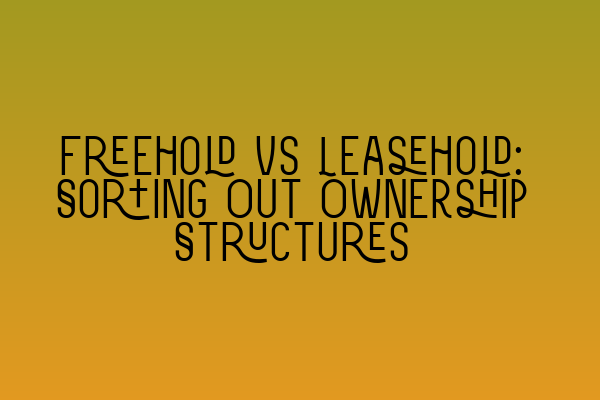Freehold vs Leasehold: Sorting Out Ownership Structures
When it comes to property ownership, understanding the difference between freehold and leasehold is crucial. These two ownership structures have significant implications for property owners and can greatly impact the rights and responsibilities associated with a property. Whether you’re a prospective buyer, a property investor, or a solicitor practicing property law, it’s essential to have a clear understanding of freehold and leasehold ownership and the differences between them.
What is Freehold Ownership?
Freehold ownership, also known as fee simple ownership, grants the owner absolute and indefinite ownership rights over a property. When you own a property freehold, you have complete control, including the land on which the property stands. You are the sole owner with no time restrictions, and there is no expiration date on your ownership.
With freehold ownership, you have the freedom to make decisions regarding your property without seeking permission from anyone else. You are responsible for the maintenance, repairs, and any modifications to the property. Additionally, you have the right to sell, rent, or transfer the property as you see fit.
As a solicitor dealing with freehold properties, it’s important to ensure your clients understand the full extent of their ownership rights. SQE Property Law & Land Law offers comprehensive courses on property ownership and can help you prepare for the SQE exams if you’re studying to become a solicitor.
What is Leasehold Ownership?
Leasehold ownership, on the other hand, involves a lease agreement between the property owner (known as the freeholder) and the leaseholder (the individual who occupies the property for a fixed term). In leasehold ownership, the leaseholder does not own the property outright, but rather has a leasehold interest in it for a specified period.
Leasehold ownership can be for a long-term lease, such as 99 or 125 years, or a shorter period, such as 25 or 50 years. During the lease term, the leaseholder has the right to live in and use the property, subject to any restrictions outlined in the lease agreement. However, the freeholder retains legal ownership of the property.
Leasehold ownership often involves the payment of ground rent, service charges, and other fees to the freeholder, who is responsible for maintaining the common areas and external structure of the property. Leaseholders may also need to seek permission from the freeholder for alterations or modifications to the property.
Understanding the intricacies of leasehold ownership is essential for both solicitors and property owners. SQE Property Law & Land Law offers in-depth training on leasehold ownership and can help you navigate the complexities of leasehold transactions.
Key Differences between Freehold and Leasehold
Now that we have briefly explained freehold and leasehold ownership, let’s delve into the key differences between the two:
1. Ownership Duration:
Freehold ownership provides indefinite ownership rights, with no expiration date, while leasehold ownership is limited to the duration outlined in the lease agreement.
2. Control and Decision-Making:
With freehold ownership, the property owner has complete control and decision-making power over the property. In leasehold ownership, the leaseholder has restrictions and may need to seek permission from the freeholder for certain actions.
3. Responsibilities:
Freehold owners are responsible for all maintenance, repairs, and modifications to the property. In leasehold ownership, the freeholder is typically responsible for the upkeep of common areas, while the leaseholder may have responsibilities outlined in the lease agreement.
4. Costs and Fees:
Leaseholders often have ongoing financial obligations, such as ground rent and service charges, payable to the freeholder. Freehold owners are not typically subject to these additional costs.
Choosing between Freehold and Leasehold
When purchasing a property, it’s important to consider which ownership structure suits your needs and preferences. Freehold ownership provides maximum control and long-term ownership, while leasehold ownership offers flexibility, particularly for those who may only require the property for a fixed period.
As a solicitor, it is your responsibility to guide your clients through the decision-making process and ensure they fully understand the implications of their chosen ownership structure. Providing accurate and transparent advice is essential for building trust and client satisfaction.
At SQE Property Law & Land Law, we offer comprehensive preparation courses for the SQE exams, including detailed guidance on property ownership structures. Our courses will equip you with the knowledge and expertise necessary to provide exceptional legal services to your clients.
Are you preparing for the SQE exams? Check out these related articles:
- SQE 1 Practice Exam Questions
- SQE 1 Practice Mocks FLK1 FLK2
- SQE 2 Preparation Courses
- SQE 1 Preparation Courses
- SRA SQE Exam Dates
Prepare yourself for success in the property law and land law domains of the SQE exams with SQE Property Law & Land Law. Our expert tutors, comprehensive study materials, and mock exams will ensure you are fully prepared to excel in your legal career.
For further information about our courses and services, visit our website or contact us today. Take the first step to become a qualified solicitor specializing in property law!
